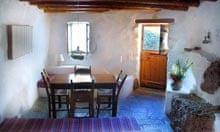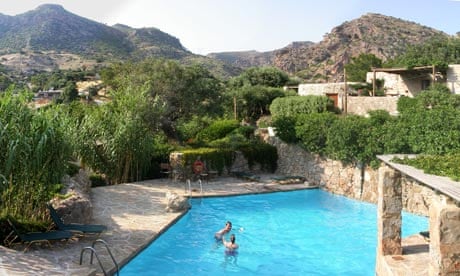It would be churlish to complain about the long tubes of white plastic, like chunky, sun-deprived caterpillars, that take up every available tract of flat land (they are, after all, protecting crops, and thus local livelihoods), but once you've accepted them, driving east along Crete's southern coast is still to be assailed by a heart-sinking array of monuments to thoughtless development: abandoned skeletons of houses, metal rods waving through flat concrete roofs at the sky; swathes of knobbly concrete lumbering down to turquoise water; garish signs promising villas in the sun, and fish and chips.
By the time we got to Makrigialós and turned left down a bumpy track, away from the sea, we were sceptical and tired, and really quite grumpy.

The White River Cottages, just a kilometre inland, came as such a relief after that. All the visual clamour dies away, and what's left is a hamlet of 13 interlocking stone cottages so in tune with the rocky hillside that it occasionally takes a moment to realise that what you're looking at is a roof or a wall. During the day the cicadas scream blue murder, but at dusk, at night and in the early morning, the silence is deep and clear.
And the cottages themselves are calm and cool. The walls are over 1½ft thick and inside, apart from the occasional abutment of exposed rock or recess of fireplace, they are whitewashed. The decor is minimalist but warm: rust-red bedspreads, a vase of flowers, a cookbook and a carafe of local wine. Every cottage has a terrace with a view - of olive groves, mountain, or Libyan Sea, or of all three - a thoughtful piece of planning that, combined with the fact that all the terraces are private, and none look in on each other, must have required a particularly fiendish bit of architectural origami. Ours had an ancient olive tree shading the table; a lemon tree that already bore one yellow lemon (and a flower or two; it seemed a little confused) nudged up against the wall.
Maria Kostantakaki, the housekeeper, sells olive oil, fresh eggs and honey from her village, and Makrigialós, with its greengrocers and long cool butcher's shop selling cured meat and sheep's milk cheese, and its well-stocked bakeries, turned out to have its uses. With food this good the terrace was the perfect place for breakfasts of Greek yoghurt, local honey and peaches, quiet lunches of Greek salad and fresh bread; and for afternoons of reading, watching the breeze reveal the silvery undersides of the olive leaves and, one surprising day, listening to a violinist practising what sounded like Brahms. It was also a great place to get bitten by mosquitoes.
When they became too irritating, there was the swimming pool. Though there nearly wasn't one, apparently; Vangelis Mavrakis, 56, who bought and began converting the abandoned hamlet in 1986, says his friends tried to persuade him it wouldn't be in keeping with the spirit of the place. I'm glad he decided not to listen to them. It isn't very big, but the loungers and flagstones are tasteful, the gardens surrounding it, of whispering bamboo and flowering cactus, carob and oleander, well-kept. To float in the cool water and look up at the blue sky and surrounding hills is a real treat.
Mavrakis, a thoughtful and slightly morose economist from Heraklion, oversaw all the building himself, and still spends hours working out how exactly to provide air-conditioning or free Wi-Fi, say, without ruining the rustic look. The hamlet was originally built for families coming down to the coast for the olive-picking season and he shows me photographs of their ruins - fireplaces open to the sky, wildflowers growing through the floors. There was no road when he began, so all the materials had to be brought up by donkey. He spent months looking for good stonemasons among villagers who thought he was mad to be converting it at all. But it's worked: the cottages fill with Greek tourists in July and August, when temperatures can rise to 42C; northern Europeans tend to come early or late in the season, when it's a bit cooler and they can hike through the surrounding hills.
He makes no secret of his annoyance over the housing boom. "The people who destroyed Spain have destroyed Crete. Makrigialós was always ugly, but construction has been overdone. There's no vision." He is worried by the fact that even before the economic crisis tourism was declining because, in his view, Crete competes with countries like Morocco, Tunisia, and Egypt - rather than Italy, France or Spain - but no longer has their low cost of living. So more projects will be left unfinished, more tourist development abandoned.
In the meantime he and his warm, efficient administrator, Iris van der Kaay (who used to work as a social worker and in advertising in Amsterdam), suggest ways to avoid the eyesores. Diaskari beach, for example, just along from the pounding music and idling cars of Makrigialós beach, where utterly clear water laps at sand and stony outcrops are embedded with pebbles of red, blue, white, and green, like a natural mosaic. Or the pretty mountain village of Pefki, where a 100-year-old pepper tree is the focal point and the quiet whitewashed cottages, surrounded by flowers, all look out to sea.
A ravine that traces its rocky, pine-shaded way from Pefki to sea level is a popular hike (I declined to attempt it in the heat - it was generally 30C by 9am - but if you're good at early mornings or there out of summer, it looks like a pleasant thing to do). There are monasteries and boat trips; there's shiatsu, thanks to Iris's Israeli husband, Amnon Tepper (who likes Crete because "it's like Israel but without the war"), and the annual Casa dei Mezzo music festival, where musicians from all over the world come to a Norwegian businessman's villa in the hills to play, this year, Gershwin and Gounod and Rachmaninov; Schubert, Pärt and Mendelsohn. That explained the ghostly Brahms. There was also Greek poetry and some specially commissioned music. Gunnar Strømsholm established the festival because "the 'culture' that some visitors bring with them does not always impress the locals."
But the main thing, for me, was the quiet cottages, their calm and restfulness, and blue pool at their centre.
